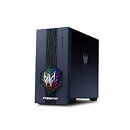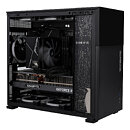
ASRock Unveils New Radeon AI PRO R9700, RX 9060 XT, and ARC Pro B60 Graphics Cards at Computex 2025
ASRock had plenty of new graphics cards at the Computex 2025 show, with a few interesting pieces in its Creator Series, including the new AMD Radeon AI PRO R9700 and Arc Pro B60 graphics cards. In addition, ASRock showcased the newly announced AMD Radeon RX 9060 XT graphics cards that will be available in both Challenger and Steel Legend series.
The ASRock Creator Series is an interesting one as this is aimed at "multi-GPU collaborative computing," meaning it is designed for multi-card computing. This is the reason why the ASRock Creator Series uses a blower-style dual-slot cooler design with vapor chamber heatsink. It also comes with 0dB Silent Cooling and a metal frame construction. ASRock also unveiled two new graphics cards in its Creator Series, the Radeon AI PRO R9700, based on the newly announced RDNA 4-based Radeon AI Pro R9700, which is basically a beefed up version of the Radeon RX 9070 XT, maxing out the 4 nm Navi 48 GPU with 64 compute units and 32 GB of 20 Gbps GDDR6 memory on a 256-bit memory interface, and the Intel Arc Pro B60 Creator, based on Intel's recently announced Arc Pro B60 GPU. The Arc Pro B60 is based on Intel Xe2-HPG architecture with 160 Intel XMX engines and coming with 24 GB of 20 Gbps GDDR6 memory on a 192-bit memory interface.
The ASRock Creator Series is an interesting one as this is aimed at "multi-GPU collaborative computing," meaning it is designed for multi-card computing. This is the reason why the ASRock Creator Series uses a blower-style dual-slot cooler design with vapor chamber heatsink. It also comes with 0dB Silent Cooling and a metal frame construction. ASRock also unveiled two new graphics cards in its Creator Series, the Radeon AI PRO R9700, based on the newly announced RDNA 4-based Radeon AI Pro R9700, which is basically a beefed up version of the Radeon RX 9070 XT, maxing out the 4 nm Navi 48 GPU with 64 compute units and 32 GB of 20 Gbps GDDR6 memory on a 256-bit memory interface, and the Intel Arc Pro B60 Creator, based on Intel's recently announced Arc Pro B60 GPU. The Arc Pro B60 is based on Intel Xe2-HPG architecture with 160 Intel XMX engines and coming with 24 GB of 20 Gbps GDDR6 memory on a 192-bit memory interface.










































































